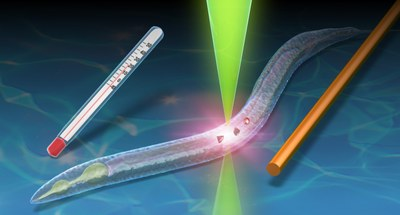Sep 14 2020
Quantifying the temperature of objects at nanoscale has been a challenge for a long time, particularly in live biological specimens, because of the absence of dependable and accurate nanothermometers.
 Temperature of C. elegans measured via tracking of embedded nanodiamonds. Image Credit: ©Masazumi Fujiwara, Osaka City University.
Temperature of C. elegans measured via tracking of embedded nanodiamonds. Image Credit: ©Masazumi Fujiwara, Osaka City University.
Now, an international research group has developed a quantum technology to explore temperatures on a nanoscale, and has detected a “fever” in minute nematode worms under pharmacological treatment. This reinforces the link between biology and quantum sensing and promotes unique thermal imaging technologies in biomedical research.
At a glance
In association with other international partners, the researchers from Osaka City University have presented the dependable and precise microscope-based thermometer that works in living, microscopic animals based on quantum technology, mainly for detecting temperature-reliant characteristics of quantum spins in fluorescent nanodiamonds.
The study has been published in the Science Advances journal.
Overview
The optical microscope is one of the most standard tools used for analysis in the field of biology. It employs visible light to permit the human’s naked eye to visualize very tiny configurations. In today’s laboratory, a fluorescence microscope, which is an improved model of the optical microscope with numerous fluorescent biomarkers, is used more often.
The latest developments in fluorescence microscopy have facilitated live imaging of structural details. With the help of this method, it has become easy to acquire numerous physiological factors in these structures, such as reactive oxygen species, pH, and temperature.
Quantum sensing can be described as a technology that manipulates the ultimate sensitivity of delicate quantum systems to the immediate environment. High-contrast MRIs are instances of quantum spins in fluorescent diamonds and are a few of the most sophisticated quantum systems operating at the helm of real-world applications.
This method was applied to thermal biology seven years ago to measure temperatures within cultured cells. But they were still not used on dynamic biological systems, where temperature and heat are more dynamically involved in biological processes.
The surface of nanodiamonds was first decked with polymer structures and then injected into C. elegans nematode worms—one of the most widely used model animals in biology.
The team wanted to learn the base “healthy” temperature of the worms. As soon as these nanodiamonds were inside the worms, they traveled rapidly but the unique quantum thermometry algorithm developed by the researchers effectively tracked them and consistently quantified the temperature.
The team then induced a fever inside the worms by triggering their mitochondria with a pharmacological treatment. The quantum thermometer developed by the researchers effectively observed an increase in the temperature of the worms.
It was fascinating to see quantum technology work so well in live animals and I never imagined the temperature of tiny worms less than 1 mm in size could deviate from the norm and develop into a fever. Our results are an important milestone that will guide the future direction of quantum sensing as it shows how it contributes to biology.
Masazumi Fujiwara, Lecturer, Department of Science, Osaka City University
The strategic grant of the Osaka City University spearheaded this international and interdisciplinary association of six institutions from four nations, including Osaka City University, Keio University, Kyoto University from Japan, Humboldt University of Berlin (Germany), Soochow University (China), and Chapman University (United States).
The study was jointly authored by Fujiwara, Sun, Dohms, Nishimura, Suto, Takezawa, Oshimi, Zhao, Sadzak, Umehara, Teki, Komatsu, Benson, Shikano, and Kage-Nakadai.
Get Diamonds, Take Temperature
Video Credit: Osaka City University.
Journal Reference:
Fujiwara, M., et al. (2020) Real-time nanodiamond thermometry probing in-vivo thermogenic responses. Science Advances. doi: 10.1126/sciadv.aba9636.